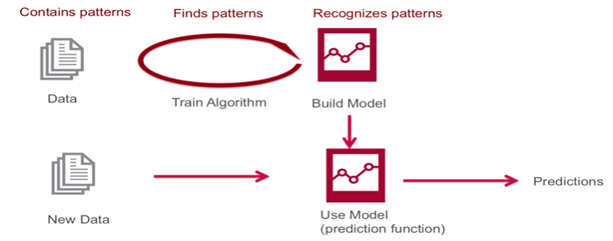Artificial intelligence (AI), data science, web design and development are the three major domains collectively shaping the world of the internet right now. However, nothing may immediately come to one’s mind to establish a correlation among the three, says Yash Mehta.
But if motivated to think of some examples, it gradually becomes clear if we think of how ads relevant to us come up while browsing the web or how Amazon uses our previous search data to automatically display relevant products every time we browse through it.
As consumer behaviour and markets change over time, data-driven technology and applications becomes a necessity to strategise businesses. Founder of DomainMagnate, Michael Bereslavsky says “we are presently at a time where the capability of technologies like data science and AI improves day by day and perhaps it might even be possible where certain strategic business solutions are provided by AI itself based on financial data indicators”. Therefore, to understand how AI and data science can help in web design, a brief overview of the respective domains becomes necessary.
Overview of machine learning, web designing and data science
Machine learning (ML) is a type of AI in which a system has the ability to automatically perform functions by recognising patterns from the data it receives without the need for explicit programming instructions. Machine learning, together with the other areas of AI like deep learning, is currently one of the hottest trends in computer science research at universities as well as at corporations like Facebook, Google, IBM, etc., Tools utilised for ML majorly include R and Python packages.
Web design and development are like the two faces of the same coin wherein a web designer designs a website, specifies the layout, colour, typesetting, etc. They are also responsible for outlining a good UX design similar to the role of an architect in construction. Whereas a web developer brings life to that design because they develop the functionality of web pages, making it responsive and interactive for users similar to the role of engineers in construction.
Web designers often use Photoshop, Illustrator and similar softwares. They also benefit from knowing languages like HTML, CSS3, JavaScript etc., Web developers, on the other hand, are required to know a wide range of languages that include but are not limited to HTML, CSS, PHP, JavaScript, jQuery, MySQL etc., depending on whether they are front-end or back-end developers.
Data Science, in crude words, is the science (or as some say, pseudoscience) of making sense out of the data that is available for various purposes which is mainly concerned with optimisation. Various tools are employed for achieving this and it requires knowledge on a variety of fields namely statistics, Python, computer science etc.
So how exactly do machine learning and data science help web designing?
The essential process by which ML and data science integrate and operate together is summed up simplistically in the picture below.

To get an intuitive feel of how these domains can be brought together in web designing, let’s take a look at how one company employs them for their services.
Bookmark is a start-up that specialises in providing web designing services. It is done by employing what they call ‘Artificial Intelligence Design Assistant’ or ‘AiDA’. It is primarily intended for those who do not have the requisite coding skills and want to invest less in building a website in a short time. AiDA basically utilises ML and data mining to create a mobile website design in a few minutes, for which a human web developer currently takes at least a week, by taking some relevant information from a user.
For example, if a user specialising in photography wants to start his/ her own website to showcase his/ her portfolio, the user can do so by providing some relevant information regarding the area to AiDA and it automatically crawls the websites of similar nature, competitor portfolios and, etc. It further recognises a pattern to determine how the user’s web page requires to be structured and what layouts, elements and colours needs to be used, within a few minutes.
Grid is another company that uses AI to help customers build their own website besides Bookmark. However, given that the technology is in its growth phase, it might be unreasonable to expect that algorithms such as AiDA’s can provide the professional and robust functionality a web developer could right now. Keeping in mind that machine learning improves the platform each time as it recognises a pattern from the data, in future as AI technology matures it is very likely that AiDA-like platforms can become as effective as developers.
Now that we saw how ML can change the way web designing is done conventionally, let’s see how exactly it helps:
1. Prioritising personalised content
According to Monetate 2017, out of the companies that exceeded revenue expectations, 79% of them had a documented personalisation strategy. This makes it evident that personalisation strategies are already on the agenda of businesses and therefore AI is set to play a major role in it.
Just like how we require some familiarity with behavioural patterns of people to predict their reactions upon certain events, personalisation also requires forming patterns from user data. Hence, machine learning requires data mining, statistical analysis and other data science tools and processes to be integrated into a system necessary to customise content based on pattern recognition.
It is done in a manner similar to how Youtube recommends videos based on our Youtube history but in a relatively better way. In web designing, this level of complexity can enable a page to customise content itself or let the developers know the user preferences based on location data from where users access the page.
2. Recognising users’ browsing behaviour
Understanding user behaviour such as the average time spent on a page, the type of content which users view, the page which they were possibly redirected to etc., can be of immense importance for enhancing websites as well as for strategising businesses. For example, if a user were redirected from a site that offered excellent browsing experience and if the user spent considerably less time in the redirected site, the behaviour observed could be narrowed down to a handful of reasons and adding the traffic, it would provide insights on various elements including how a website may be improved.
Hence a complex algorithm that relies on ML and data analysis could enable an increased user interaction by improving responsiveness and user experience of the website. It can also set up an intuitive interface to provide customised answer to queries based on the content users view and improve the algorithm itself based on such inputs for giving dynamic responses over time.
3. Increasing the effectiveness of developer roles
Employing machine learning and data science in web design or development allows the developers to utilise their time for more innovation in design and development. It also allows them to take up strategic roles while they are only required to tweak areas in the web platform for improving its overall performance.
To wrap up, major corporations around the world have fully embraced the functional role machine learning can provide together with data science tools. The role they play in web design and development allows for a better optimisation which consequently leaves room for more innovation for the developers at the ground level. Keeping in mind the swift pace at which technology is increasingly becoming integrated into our daily lives and overtaking businesses, it becomes necessary to adapt to the changes.
The author of this blog is Yash Mehta an IoT and Big Data Science expert. He is an award-winning writer appearing in many publications
Comment on this article below or via Twitter: @IoTNow OR @jcIoTnow










